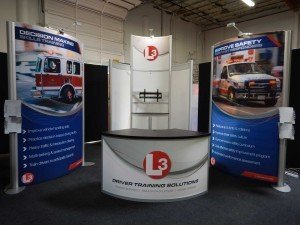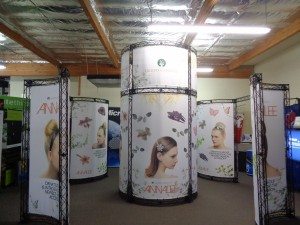12 Easy Tips to Save Money that Booth Visitors Will Never See
There are two ways to cut costs in your trade show marketing program: with an ax or a scalpel. The ax is likely to do as much damage as good, while the scalpel can trim in places your booth visitors won’t even notice. But the results can be significant, trimming your budget substantially without cutting any of the quality you’re shooting for.
Here are twelve tips that can “take a little off the top” and also positively affect your bottom line:
1. Buy a used exhibit
As an exhibit supplier, it’s not in our best interest to suggest this. But we’re here to help your bottom line. A used exhibit can cost 50% less than new construction. Even with refurbishment and a new set of graphics, you’ll still be way ahead.
2. Consider renting your booth
Again, this isn’t going to make us as much money. But it can save you a significant amount that can go to other aspects of your trade show marketing program. You don’t have to lay out a big chunk of cash at the outset, and you can change your look more often than if you’d invested in a booth of your own that needed to be amortized over many shows.
Renting a booth is also a great interim solution if you can’t make up your mind on a booth style, or if you’re just trying out the whole concept of trade show marketing. Finally, if you overbooked and have 2 shows too close together to get your existing trade show display from one show to the other quickly enough, renting a trade show booth can be a life-saver.
3. Go digital with your graphics
Graphics can be a big—and ongoing—expense in your budget. But you can save money in the long run by putting your graphics – especially ones that change, like product pictures – on a monitor instead of printed graphics on panels or light boxes. This makes them easier to produce (even in-house), and a cinch to change for every show.

RENTAL Modified RE-9049. Includes Tower with Locking Counter, (2) Double-Sided Graphic Kiosks, and RE-1205 Large Reception Counter with Locking Door and Interior Shelf
4. Store your exhibit strategically
Many exhibitors store their booths in their exhibit company’s warehouse, since it makes for easy ins and outs. That convenience comes at a price, but can be a great deal if you need someone that knows the booth to clean and inspect it after every show – it only takes one time getting to a show and then remembering you lost a few parts at that last show! Exhibit company storage also makes it simple to swap out graphics and add accessories, and still make sure all the right bits get to the show together.
But do the math and make sure whether you’d do better by storing your exhibit materials in a company warehouse, a self-storage unit or even an empty and otherwise unused trailer.
5. Inventory what you’re storing
Many companies have booth properties in storage that they haven’t used in years. And there’s a price to be paid for storing what you don’t need any more. Ask your storage facility (or send someone over to the storage location) to give you an inventory of what you’re storing, and determine what to do with what’s not being used.
Then, you have some choices: you can ask the exhibit company to dispose of what you don’t need (there may be a fee involved). You may be able to sell your booth back to the exhibit house for their rental inventory, or sell it online.
Or you can donate the exhibit to a non-profit, which comes with some benefits. First, you’re helping a good cause. Second, you get a write off for the value of the booth you’ve donated.
6. Scale down
If your company’s product is a heavy or bulky item—or if it’s either very large or very small, consider using a model instead of the real thing. If what you sell is large (like construction equipment), a 3D model can help you tell your story effectively while saving you on the cost of shipping huge pieces of equipment. A model can also be helpful if your product is small (like microchips). A model can show features that would be too small to see on the actual product.
7. Store with strategy in mind
Transportation and shipping costs can be a big part of your budget. So take a look at your show calendar alongside a map. If the majority of your shows are in a certain part of the country, consider storing booth equipment in that area, rather than returning them to your office after each show.
Many exhibit houses arrange storage and shipping for your, and can arrange to store your equipment in strategic locations during your show season, in order to minimize shipping costs.
8. Bundle your travel costs
Travel websites sell hotel and air package deals that can be a money saver for some exhibitors. And you can often save the small, but mounting costs like breakfast, Wi-Fi or business center access by simply asking the hotel to include them. This is even more likely to go your way if you do business with the same hotel chain when you travel.
9. Cut rigging
Banners and company identification structures that are suspended from the ceiling of the exhibit hall usually require additional rigging of trusses to attach lighting to illuminate them. But if you’re clever, you may be able to build the lighting for these units into your exhibitry. Talk with your exhibit designer and see if this approach would be cost-effective for your circumstances.
10. Don’t “buy local”
It’s wise to buy your groceries locally. But when you’re spending money on hotel rooms for your staff, it can be much less expensive to stay outside the city center or even in a nearby city. You can rent a van to get staffers to the show, or in certain cities, trains stop right at the convention center. It might take a little more time to get to the show, but the money you can save may make it very worthwhile.
11. Clean carpets yourself
Booth cleaning is another expense that’s added to your bill at every show. But if you’ve got room in your crates to bring your own vacuum, you can cut the cost of cleaning without looking shoddy. If you really want to cover your bases, you may also want to send a small carpet cleaning device along, too, to handle stain removal.
12. BYOS: Bring Your Own Stuff
You can get duct tape or a surge protector on-site at most shows, but it’ll cost you an exorbitant amount of money. Put together your own road box with the supplies you’ll need, and you’ll save money every time.
Here’s another tip: you’ve got less than three seconds for a passerby to size up your exhibit and decide if he or she wants to invest more time to learn about your company. So your exhibit is a critical component of your trade show success. Is your current booth getting you noticed?
If not, let us show you what we can do to help you attract attention on the show floor. Call us at (800) 676-3976 or email [email protected].
For more ideas, check out our article on stretching your trade show budget or our article on getting the most bang for your trade show buck.

